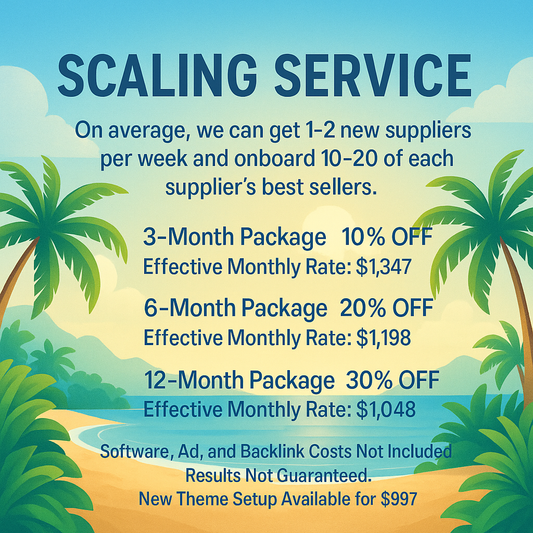
Boost Your Ecommerce Visibility with Schema Markup
Hey there, fellow entrepreneurs! Trevor Fenner here, founder of Ecommerce Paradise, and today I’m excited to delve into a game-changing topic that can help you elevate your online store's visibility and performance. If you’ve been searching for effective ways to boost your SEO, improve your Google Shopping Ads, or enhance your overall ecommerce strategy, then utilizing schema markup is a must! This blog post will explore everything you need to know about schema markup and how it can transform your ecommerce game. Let’s get started!
What is Schema Markup?
Schema markup is code that you place on your website to help search engines better understand the content on your pages. Think of it as a bridge between the data you present on your site and how it’s interpreted by search engines like Google. By using schema markup, you can enhance your listings in search engine results pages (SERPs), making them more attractive and informative for users. This leads to better click-through rates and ultimately improved SEO.
The Importance of Schema for Your Ecommerce SEO
High visibility in search engines is crucial for any ecommerce business. When your products show up with rich snippets, like star ratings or availability, they stand out from the crowd. By implementing schema markup, you can:
- Provide search engines with specific details about your products and services.
- Enhance your listings with rich snippets, making them more appealing to consumers.
- Increase your chances of appearing in Google’s Knowledge Graph.
- Ultimately improve your SEO rankings and organic traffic.
Types of Schema Markup for Ecommerce
Using the correct schema markup will vary based on what type of ecommerce business you are running. Here are some specific types of schema markup you should consider implementing:
1. Product Schema
This is one of the most important schemas for any ecommerce store. Product schema markup provides information like the product's name, price, availability, and reviews. Here’s an example of how to implement it:
<script type="application/ld+json">
{
"@context": "http://schema.org/",
"@type": "Product",
"name": "Stylish T-Shirt",
"image": "http://example.com/images/t-shirt.jpg",
"description": "A stylish t-shirt made from 100% organic cotton.",
"brand": "Your Brand",
"sku": "12345",
"offers": {
"@type": "Offer",
"url": "http://example.com/t-shirt",
"priceCurrency": "USD",
"price": "19.99",
"itemCondition": "http://schema.org/NewCondition",
"availability": "http://schema.org/InStock"
}
}
</script>
2. Review Schema
Reviews play a huge role in purchase decisions. Implementing review schema allows you to display review ratings directly in the search results, enhancing credibility and attracting buyers. It combines with product schema to show off that great reputation you’ve built!
3. Breadcrumb Schema
This is especially useful for navigation purposes. Breadcrumb schema helps search engines understand your site's structure and improves user experience. A well-structured site is critical for SEO and dropshipping businesses struggling with competition.
4. Local Business Schema
If you have a physical store attached to your ecommerce business, local business schema helps attract local customers. It helps Google present your business to relevant searches, increasing visibility for local shopping.
Setting Up Schema Markup
So, how do you get started? Here’s a step-by-step guide to implementing schema markup on your Shopify store:
Step 1: Choose Schema Markup Types
Depending on your product offerings, select the appropriate schema types you want to implement. Use the guidelines on Schema.org to determine what markup applies to your website.
Step 2: Use a Structured Data Generator
If you’re not familiar with coding, don’t worry! There are many structured data generators available online that can guide you to create the necessary schema markup without any coding skills required. Just input your product details, and the generator will produce the schema code for you.
Step 3: Implement the Code
Once you have the schema code, you will need to add it to your Shopify store. Depending on the theme you are using, you might be able to add it directly in the theme’s code. Be sure to do this carefully, as any errors can affect your site’s performance.
Step 4: Test Your Markup
After integrating your schema markup, it's essential to test it using Google’s Rich Results Test tool. Just copy and paste your product URL, and the tool will let you know if your schema markup is implemented correctly.
Step 5: Monitor Results
After implementation, keep an eye on your Google Search Console for results. Track how your products are performing in search results post-schema implementation and make adjustments as needed for optimization.
Schema Markup and Google Shopping Ads
If you're running Google Shopping Ads, you must understand the synergy between schema markup and your ads. Correctly structured data enhances the quality of your product feeds and, in turn, improves your ad performance. Here’s how:
- Product Feed Optimization: Ensure your Google Merchant Center, where your Shopping Ads come from, is enriched with schema markup. It helps Google understand your products better.
- Improved Ad Rankings: Products with well-defined schema data are more likely to get higher impressions and click-through rates.
- Increased ROI: With better visibility and engagement, your ad spending becomes more effective, leading to higher sales and better returns.
Email Marketing and Schema Markup
Now, here’s an interesting twist! Did you know that schema markup can also be used to improve your email marketing efforts? By using schema markup in your email campaigns, you can enhance the way your emails appear in recipients’ inboxes. This means that products can be presented with images, prices, and availability data directly within the email preview. These enhancements can boost your email open rates and click-through rates, providing an excellent opportunity to sell more in your dropshipping store!
Helpful Tools and Resources
To make implementing schema markup easier, consider the following tools and resources:
- Fiverr or Upwork: Hire a freelancer if you’re not comfortable doing it yourself.
- Moz: For ongoing SEO analytics and insights.
- Google Merchant Center: To manage your product feed for Google Shopping Ads.
- Schema.org: For comprehensive information on different types of schemas available.
Unlocking the Full Potential of Schema Markup
Now that you have all the knowledge and tools at your disposal, it’s time to take action! Implementing schema markup is more than just a technical SEO strategy; it’s about providing value to your customers and making it easier for them to find and buy your products.
Don’t underestimate the power of well-structured data in this highly competitive ecommerce landscape. By leveraging schema markup effectively, you can create a significant competitive edge, optimize your Google Shopping Ads, and elevate your email marketing campaigns. The visibility you gain will not only attract more potential customers but will also enhance your brand reputation. So, are you ready to boost your ecommerce visibility?
Your journey through the world of schema markup doesn’t need to be overwhelming. With the right approach and tools, you can simplify the process and get the results you desire. Remember, an informed entrepreneur is an empowered entrepreneur! Stay tuned for more insightful articles from your friends at Ecommerce Paradise, and happy selling!


















